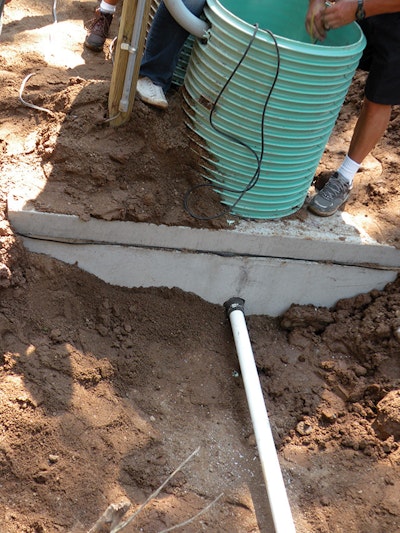
Interested in Septic Tanks?
Get Septic Tanks articles, news and videos right in your inbox! Sign up now.
Septic Tanks + Get AlertsWhen we conduct workshops and discuss inspecting and installing sewage tanks, we always stress that they need to be watertight. This usually leads to quite a discussion of what constitutes watertight, why it is important, and what happens if tanks are not watertight.
Watertight means water does not leak into or out of the tanks. If the leakage is from the tank out, sewage escapes into the soil. Since it is introduced as saturated flow, it can move into shallow groundwater or through bedrock fissures and become a source of contamination.
If water leaks or flows in, excess water is introduced to the tank. This will interfere with storage and settling of solids and reduce tank retention time. This in turn can mean premature clogging of other components, such as effluent screens. More important, inflow hydraulically overloads the soil treatment unit by creating flows much larger than the design values.
Also, when not watertight, the tanks can be subject to root penetration. Roots can block inlets and outlets and create other cracks and holes in the tank that will let water in and out. If there are roots in the tank, it is not watertight and needs to be repaired or replaced.
Leakage sources
Tanks generally are not monolithic objects. The most common sources of leaks are joints, seams and defects. These include:
The midseam joint of two-part tanks
Top seam joints for the tank lid
Access riser connections
Inlet and outlet pipe penetrations
Cracks or holes caused by poor construction or installation practices
One item sometimes overlooked is the weep hole at the tank bottom that allows water to drain out while the tank is being stored. This hole needs to be properly plugged at installation.
To the test
There are two recognized tests for watertightness: hydrostatic and vacuum. Both can be conducted where the tank is manufactured and upon installation at the site. For concrete tanks, the National Precast Concrete Association (NPCA) requires members to follow a production testing protocol to check tanks as they are manufactured. Not every tank gets checked, but there is a quality control check that involves watertightness, and it is set forth in the association's Septic Tank Manufacturing Best Practices Manual.
Installers need to recognize that they are concerned with watertightness where the tank is installed. Therefore, the best tests include all of the piping and risers that will be present as a part of the final installation. Here are short summaries of each test.
Hydrostatic test
Pay attention to manufacturers' data sheets for their products, especially when testing plastic or fiberglass tanks. Carefully follow their requirements for backfill around the tank ahead of any hydrostatic testing. For any mid-seam tank, it is important to be able to evaluate that seam. Therefore, the backfill should not cover the seam.
The inlet and outlet pipes should be plugged using pipe with a cap or some other watertight plug at the desired location in the pipe. Fill the tank to the top. If there is a riser, add water to 2 inches above the tank/riser seam. Take care not to overfill a two-piece tank, since that may cause the top to become buoyant.
Measure the water level and leave the tank for 24 hours. If there are any signs of leakage, suspect areas should be resealed. After 24 hours, refill the tank to the original level. After another 24 hours check for leaks again. If less than one gallon is lost, the tank is considered watertight. If the leaks cannot be repaired, the tank is unacceptable.
Vacuum testing
Vacuum testing is generally the preferred method, mainly because it takes less time and does not involve large quantities of water. In this test, it is again important to test the tank in the condition in which it will be when installed.
All pipe penetrations, manholes and risers must be sealed airtight. A special insert is placed on one of the manholes. Using a pump, air is evacuated from the tank to a standard vacuum level. According to the NPCA standard of practice, the recommended level is four inches of mercury. This pressure must be held for five minutes.
During this period there is an allowable pressure drop of one-half inch of mercury. If the pressure drops, it must be brought back to four inches for five minutes with no pressure drop. As with the hydrostatic test, leaks are repaired and the test repeated. If the leaks cannot be repaired, the tank should be replaced. Deformation, cracking or collapse indicates a poor-quality tank.
For fiberglass-reinforced polyester and polyethylene tanks, be sure to follow the manufacturer's guidelines on water testing to avoid damage or implosion. Information on the best practices for these tanks can be obtained from the manufacturer or from the International Association of Plumbing and Mechanical Officials (IAPMO), which has a material and property standard for prefabricated septic tanks.
Keep it legit
As always, pay attention to local and state requirements. Those regulations usually stipulate that if there is any difference between local requirement and national standards, the local requirements take precedence.
We also get questions on watertightness for existing tanks, particularly for real estate inspections or for inspections in conjunction with maintenance contracts. Here, it is important to pump the tank and conduct a thorough visual inspection both for watertightness and structural integrity. A hydrostatic or vacuum test would require a day or more.
A visual inspection should reveal any cracks or holes that can let water in or out, and identify root penetration. Always exercise caution when pumping tanks and conducting tests to avoid collapsing the tank or, in the case of high groundwater, having the tank float to the surface.






